#sully boyar
Explore tagged Tumblr posts
Text



DOG DAY AFTERNOON (1975) dir. Sidney Lumet.
#melisgifs#moviegifs#movieedit#dailyflicks#film#movies#entertainblr#filmedit#filmgifs#filmtv#fyeahmovies#tvandfilmdaily#tvandfilmgifs#cinemapix#cinematv#dog day afternoon#al pacino#pacino saturday#sonny wortzig#sonny wortzik#sidney lumet#1970s#70s#sully boyar#Penelope Allen#salvatore naturale#john cazale
382 notes
·
View notes
Text






What are you doing in there?
DOG DAY AFTERNOON (1975)
#clown to clown communication#in a nicer world these two would have made fifty movies together and I would have gleefully watched them all#dog day afternoon#al pacino#john cazale#sully boyar#sonny wortzik#sal naturile#sidney lumet#filmedit#movieedit#filmgifs#70s#70s film
191 notes
·
View notes
Text

Dog Day Afternoon, Mexican lobby card. 1975
13 notes
·
View notes
Text


Dog Day Afternoon (1975) dir. Sidney Lumet
#Dog Day Afternoon#movie#1970s#собачий полдень#Al Pacino#John Cazale#Charles Durning#Chris Sarandon#Penelope Allen#Sully Boyar
80 notes
·
View notes
Text
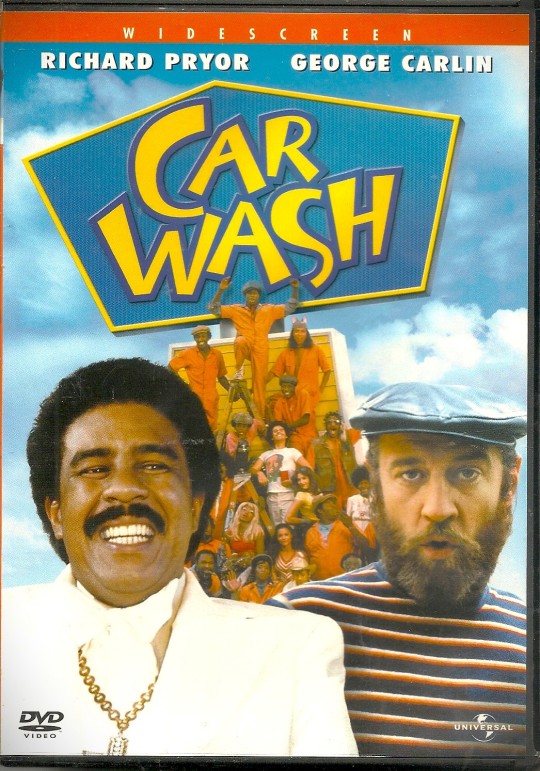
Bad movie I have Car Wash 1976
#Car Wash#Franklyn Ajaye#Sully Boyar#Richard Brestoff#George Carlin#Irwin Corey#Otis Day#Ivan Dixon#Bill Duke#Michael Fennell#Arthur French#Antonio Fargas#Lorraine Gary#Darrow Igus#Leonard Jackson#Lauren Jones#Jack Kehoe#Henry Kingi#Melanie Mayron#Garrett Morris#Clarence Muse#Leon Pinkney#Richard Pryor#Tracy Reed#Pepe Serna#James Spinks#Ray Vitte#Renn Woods#Erin Blunt#Janine Williams
1 note
·
View note
Text
Dog Day Afternoon (1975)
My ★★★★★ review of Dog Day Afternoon #FilmFriday #MovieReview
Dog Day Afternoon (1975) Synopsis – Three amateur bank robbers plan to hold up a bank. A nice simple robbery: Walk in, take the money, and run. Unfortunately, the supposedly uncomplicated heist suddenly becomes a bizarre nightmare as everything that could go wrong does – Dog Day Afternoon. Plot – Sidney Lumet Starring – Al Pacino, John Cazale, Sully Boyar Genre – Crime | Drama Released –…

View On WordPress
#1970s Cinema#Al Pacino#★★★★★#Bridesmaid#cinema#Crime#Drama#film review#Film Reviews#John Cazale#lgbt#movie review#Sidney Lumet#Sully Boyar
0 notes
Link
biografia de John Wojtowicz
Chase Bank, 450 Avenue P in Gravesend Brooklyn
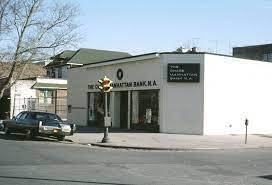
#1975#thomas moore#p.f.kluge#john cusack#USA#al pacino#john cazale#biography#Crime#Drama#thriller#history
2 notes
·
View notes
Text
Carla Moran, a hard-working single mother, is raped in her bedroom by someone — or something — that she cannot see. Despite skeptical psychiatrists, she is repeatedly attacked by this invisible force. Could this be a case of hysteria or something more horrific? Credits: TheMovieDb. Film Cast: Carla Moran: Barbara Hershey Phil Sneiderman: Ron Silver Billy: David Labiosa Dr. Weber: George Coe Cindy Nash: Margaret Blye Dr. Cooley: Jacqueline Brookes Gene Kraft: Richard Brestoff George Nash: Michael Alldredge Joe Mehan: Raymond Singer Julie: Natasha Ryan Kim: Melanie Gaffin Jerry Anderson: Alex Rocco Mr. Reisz: Sully Boyar Woody Browne: Tom Stern Dr. Walcott: Allan Rich Film Crew: Director: Sidney J. Furie Screenplay: Frank De Felitta Producer: Harold Schneider Casting: Barbara Claman Editor: Frank J. Urioste Production Design: Charles Rosen Set Decoration: Jerry Wunderlich Hairstylist: Christine Lee Makeup Artist: Zoltan Elek Construction Coordinator: Bruce J. Gfeller Leadman: Nigel A. Boucher Set Designer: Daniel Gluck Set Designer: Boyd Willat Sound Effects Editor: Keith Stafford Sound Re-Recording Mixer: Gregg Landaker Sound Re-Recording Mixer: Steve Maslow Sound Re-Recording Mixer: Bill Varney Stunt Coordinator: Chris Howell Camera Operator: Joe R. Marquette Jr. Still Photographer: John R. Hamilton Gaffer: Jon Timothy Evans Costume Supervisor: Nancy McArdle Music Editor: Ken Wilhoit Script Supervisor: H. Bud Otto Studio Teachers: Arlene Singer-Gross Unit Publicist: Lyla Foggia Location Manager: Robert Eggenweiler Original Music Composer: Charles Bernstein Director of Photography: Stephen H. Burum Executive Producer: Michael Leone Executive Producer: Andrew Pfeffer Stand In: Marcia Karr Property Master: Barry Bedig Sound Mixer: Willie D. Burton Special Effects Makeup Artist: James Kagel Special Effects Makeup Artist: Stan Winston Production Manager: David Salven Second Assistant Director: William Cosentino Assistant Property Master: Gene Anderson Leadman: Frank L. Brown Construction Foreman: Richard Eckols Painter: Anthony ‘AJ’ Leonardi Jr. Paint Coordinator: John Tyrrell Propmaker: Mark Sparks Cableman: Robert W. Harris Boom Operator: Marvin E. Lewis Special Effects: Martin Bresin Special Effects: Joe Digaetano Special Effects: Joe Lombardi Special Effects: Steve Lombardi Special Effects: Gary Monak Special Effects: Robert G. Willard Special Effects Makeup Artist: Jill Rockow Visual Effects Designer: William Cruse Visual Effects Camera: Sam DiMaggio Visual Effects Production Assistant: Margaret Goldsmith Visual Effects Production Assistant: Julie Kelly Visual Effects Production Assistant: Kim Waugh Stunts: John Ashby Stunts: Janet Brady Stunts: Ron Burke Stunts: William H. Burton Sr. Stunts: Eddy Donno Stunts: Kenny Endoso Stunts: Donna Garrett Stunts: Buddy Joe Hooker Stunts: Shawn Howell Stunts: Tommy J. Huff Stunts: Linda Jacobs Stunts: Gary McLarty Stunts: Ernie F. Orsatti Stunts: Harry Wowchuk Grip: Leon Ayres Grip: Ben Beaird First Assistant Director: Tommy Thompson Movie Reviews: John Chard: Very up and down in its telling of an horrendous story. This is the loosely based on facts story of Carla Moran, a woman who was allegedly tormented and sexually molested by an invisible demon. Regardless of if the facts of the case are fictionalised for impact, or if indeed there is any basis of truth to the attacks in question, The Entity as a film fails to rise above average due to sloppy direction and a very poor script, whilst the score from Charles Bernstein is akin to being hit over the head repeatedly with a blunt instrument. That said, the film isn’t a total wash out, there are genuine moments of dread in the piece, and most of the tension and fear is realised from a very credible performance from Barbara Hershey as Carla. The nature of the beast with this type of picture will always be open to either scoffing or a fear of the unknown, so to get the audience involved with a topic like this you really need your protagonist to be believable, Hershey manages to do this in spite of the character bei...
0 notes
Photo

Day dog afternoon, un drame social déguisé en braquage

Un film de Sidney LumetAvec: Al Pacino, John Cazale, Charles Durning, Chris Sarandon, James Broderick, William Bogert, Penelope Allen, Sully Boyar, Beulah Garrick, Carol KaneDes gangsters débutants braquent une banque et se retrouvent cernés par la police et les médias. Ils prennent en otage les employés de la banque. Débute alors un cauchemar qui va durer des heures…
Retrouvez l'article complet ici https://lemagcinema.fr/films/day-dog-afternoon-un-drame-social-deguise-en-braquage/
0 notes
Link
biografia de John Wojtowicz
Chase Bank, 450 Avenue P in Gravesend Brooklyn

#1975#Sidney Lumet#thomas moore#P.F. Kluge#usa#al pacino#john cazale#charles durning#biography#crime#drama#thriller#history
0 notes
Photo










In the Soup (1992, Alexandre Rockwell)
4/1/22
#In the Soup#Steve Buscemi#Seymour Cassel#Jennifer Beals#Will Patton#Sully Boyar#Pat Moya#Jim Jarmusch#Carol Kane#Stanley Tucci#Sam Rockwell#90s#comedy#drama#New York#starving artists#directors#neighbors#crime#producers#ambition#film production#fundraising#poverty#apartment building#indie#quirky
24 notes
·
View notes
Text






DOG DAY AFTERNOON (1975) dir. Sidney Lumet.
#melisgifs#moviegifs#movieedit#dailyflicks#film#movies#entertainblr#filmedit#filmgifs#filmtv#fyeahmovies#tvandfilmdaily#tvandfilmgifs#cinemapix#cinematv#dog day afternoon#al pacino#pacino saturday#sonny wortzig#sonny wortzik#sidney lumet#1970s#70s#sully boyar#Penelope Allen
334 notes
·
View notes
Text
31 (Films) to Life: Dog Day Afternoon (1975) - Recap and Review
Based on a true story time!

Well, this review��s coming a little late for Pride Month, but who cares? Every month is Pride Month, or Black History Month, or International Women’s Month, etc. for me. SO, let’s talk a little bit about New York City in the 1970s. It...it was really, really bad for basically everybody. New York was a crime-ridden, X-rated, terrifying hellscape for a lot of people. Both of my parents grew up here during this time period, and they constantly told me how dangerous New York City was. If you’re going there or would like to go there today, don’t worry! NYC is one of the safest cities in the world nowadays. But back then? Well...
Sex workers were all over Times Square and Central Park, with the latter being one of the most frequent areas for muggings and sexual assault. And for the record, I’m not saying that sex workers were the problem themselves; they were instead indicative of a failing economy and people in desperation for some kind of income. Also indicative of that financial destitution is the record number of homeless and drug dealers (pre-crack epidemic) in the city at the time, combined with police corruption and thriving crime families.
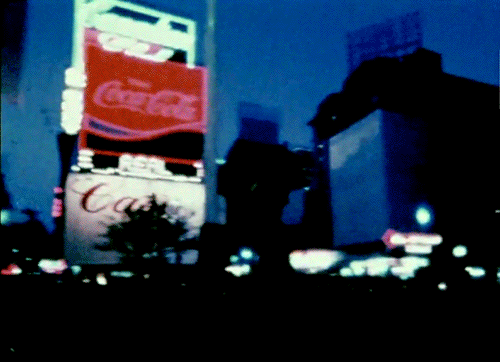
So, why was money so hard to come by at this point? Simple: the city was too big. Well, OK, not simple, but I’m not an economist. NYC’s spending vastly outweighed its budget, and the city was going bankrupt as a whole. They couldn’t borrow more money from the government, and bad accounting meant that they vastly underestimated how much money they actually needed. And this may actually explain the attitude of some boomers today in terms of things like wide healthcare and free university education. Yeah, really. Higher education was free, and there were better medical benefits for residents of the city. And look where that got them, I guess? Again, though: bad accounting and other decisions caused those issues, but try telling that to some boomers.
Things changed fast, as the city attempted to bandage its hemorrhaging funds, but nothing they tried really worked. They shook down unions, instituted layoffs, turned sales tax into state tax...and then President Gerald Ford refused to give them a loan. Shit. SHIT! By this point, it’s 1975, and we have problems, especially considering what’s on its way.

In the summer of 1976, the city is gripped by a whole new kind of terror: serial killers. David Berkowitz, also known as the “Son of Sam”, is rampaging around the city killing young white women with long dark hair, killing them in parked cars all throughout the summer, as well as the following year. At the same time, Richard “Times Square Killer” Cottingham has been killing people in the city since 1967. Not to mention gang violence, rape, muggings, and...

Before I get into this part, I need to remind you guys of something: none of this stuff I’ve been talking about, NONE of this, is even mentioning race and sexual orientation-based prejudice and disparities. And part of that is because so much crime in those sectors probably wasn’t reported, but it’s also because shit was bad for EVERYBODY at the time in NYC. But it’s important before we move on to talk about LGBT rights in the city in the 1970s. Oh, and I am a straight cissexual male, just to be clear.
While all civil rights in the city is a complex and intricate topic for another time, LGBT rights was especially present in 1970s New York City. One year before the decade began, in 1969, the police executed a routine raid on the Stonewall Inn. And I say routine because gay bars and LGBT-friendly institutions were targeted at the time purely out of institutionalized homophobia. I mean, that’s not even a conspiracy, it’s just true. Officials considered homosexuality a perversion that ruined the image of the city. ‘Cause, y’know, as I’ve been pointing out thus far, their image was sparkly clean at the time. This hypocrisy drove them to perform “sweeps” for gay people, mandating “gender-appropriate” clothing and enforcing the firing of people who were suspected as non-heterosexual. Horrid.

Back to Stonewall, 1969. On June 28, 1969, the cops raided the Stonewall Inn, which was indeed an LGBT club that served alcohol...without a liquor license. To be fair, that system was also rigged against gay clubs for the same reasons, and had previously paid off corrupt cops (with a payment called the gayola, which is admittedly a fun word to me). Their patrons were white, black, and Hispanic members of the LGBT community, and it was the most important gay bar in the city. So, when the cops raided it that morning...it didn’t go well for anyone.
I won’t go into all of the details of the raid, because some of them are...gross to read, but I’ll cut to the most important part. The time came for the police to arrest the patrons of Stonewall. They started by arresting members of the Mafia who were there (it’s just a normal thing for the time period), which was understandably received well. But once the LGBT crowd became the targets...well, all hell broke loose. Stuff starts getting thrown, the cops react violently (because some things never change), and the fight was on! As people started fighting for their rights and shouting “Gay power”, even the local women’s prison supported them from afar, shouting “Gay rights, gay rights!” out of the windows. And at this point, deep into the Stonewall Riot around 2 AM, is when Marsha P. Johnson shows up.
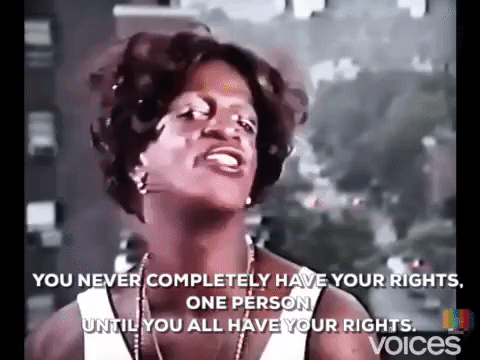
Yeah, despite what Big Mouth and a lot of people think, Marsha wasn’t there at the very beginning. That’s not to downplay her role, though. As a prominent black trans woman in the community (which barely existed at the time), Marsha soon became the figurehead of the movement. When she arrived at Stonewall, the place was on fire. Some say the cops started it, some say the protesters started it, some say the mob started it...it’s fuzzy. But one she got there, the riots raged through Christopher Street, and the cops were getting chased off the site.
By the morning, the street was wrecked and the club was history...literally. Property was destroyed, people were injured...and the Riots weren’t over yet. Night two, and thousands of people show up on Christopher Street. This time, Marsha P. Johnson was front and center, climbing a lamppost and throwing a bag through a police car windshield. More fires, more fighting, more fury. The protesters formed kick lines (yes, kick lines) against the police lines, and there was a massive standoff between the groups. By the end of it, gay rights was here, and was here PERMANENTLY. Which, y’know, is extremely good, obviously. Please look up Marsha P. Johnson for more info, because her story (and the story of her tragic and mystery-shrouded death) are extremely important to LGBT history. She really was Martin Luther Queen.

So, once we hit 1972, trans people are a known quantity in and outside of the LGBT community of NYC. And with that, FINALLY...we can talk about John Stanley Joseph Wotjowicz. And, since I’m actually about to tell you the plot of the film, for the most part...
SPOILERS AHEAD!!!
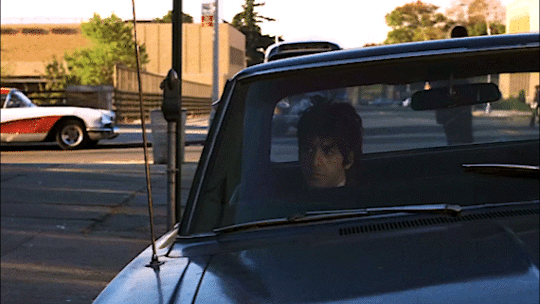
John Wotjowicz (named Sonny Wortzik and played by Al Pacino) was a Vietnam veteran who was married with kids in 1969. But that year, the same year as the Stonewall riots, the two separated. Two years later, John met and married Elizabeth Eden (named Leon Shermer and played by Chris Sarandon in the movie), a trans woman. Now, granted, it’s 1971, so gay marriage wasn’t legalized, but they still had a public ceremony. The balls, seriously! They even got news coverage over it, and didn’t receive any major repercussions.

However, Elizabeth had a nasty case of gender dysphoria, which is obviously not surprising given that she was a trans woman. In her case, though, she attempted suicide multiple times because she couldn’t afford gender reassignment surgery. And yes, this is a GREAT example of how that kind of healthcare saves the lives of countless trans youth and adults every year, but that’s a different topic for a different day...kind of. It’s actually very relevant, because Elizabeth needed the surgery, and John needed the money. And money’s tight in the 1970s for previously stated reasons, sooooooo...
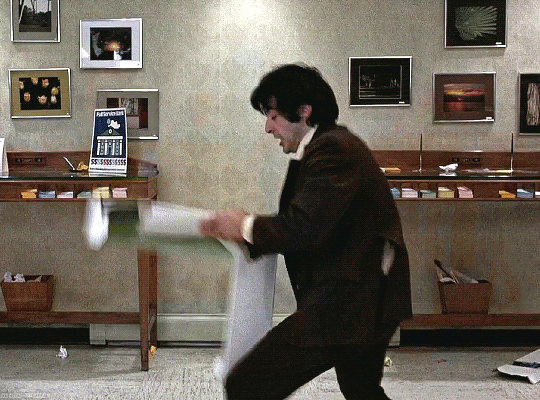
In 1972, Wotjowicz enacts his plan to rob a bank, which is the point where the film begins. After a few botched attempts, he eventually chooses a Chase Manhattan in Brooklyn. Now, common rhetoric then and now says that John did this to get the money for Eden’s surgery. However, to be completely and comprehensively accurate, he may also have committed the robbery on behalf of the Mafia to pay off a debt he owed them. Wotjowicz never confirmed which motive was more important to him, so let’s assume it may have been a combination of the two.
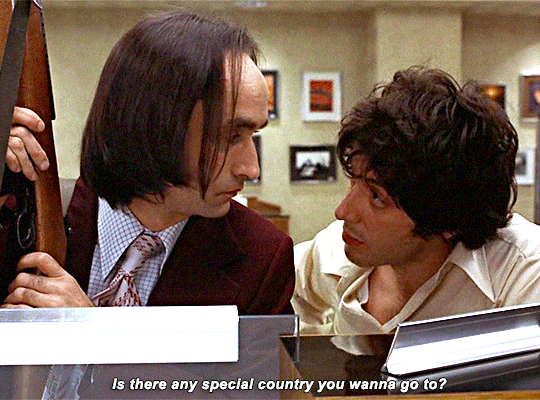
Along with partners Sal Naturile (John Cazale) and Rob Westenberg (named Stevie and played by Gary Springer in the movie), John entered the bank on August 22, 1972, and it immediately went badly for him when the cops got wind very quickly. He held seven bank employees hostage for fourteen hours, and was quickly abandoned by Westenberg, who saw the cops as they were entering the bank. Over the course of the siege, John was in correspondence with the police, and got pizza for himself and the hostages. They negotiated for a car to take them and the hostages to the airport, only for Sal to be shot while in the driver’s seat of the car at the airport. John surrendered, and was taken to jail, where he served 5 years.
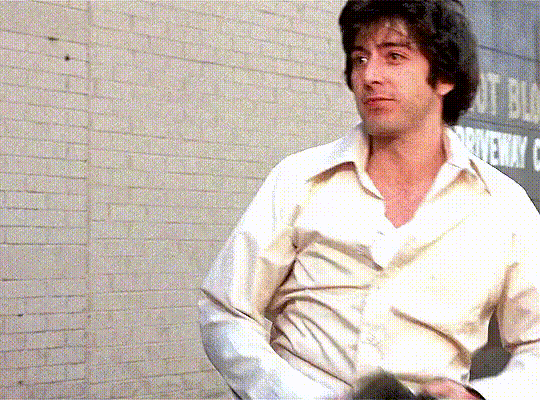
And...yeah, that’s the plot of the movie in a nutshell. Yeah, there’s some stuff about an early raid, talks with cop Eugene Moretti (Charles Durning) and FBI Agents Sheldon (James Broderick) and Murphy (Lance Henriksen), as well as a call with wife Angie (Carmen in real life, played by Susan Peretz). But in terms of the broad strokes, that’s basically it. Well, except for one famous scene, but I’ll get there in a minute.

So, John’s been arrested. While John was in prison, Eden got the surgery...then divorced him and found another guy. They stayed friends and Eden got the surgery, though, so still worth it? ALSO while he was in prison, director Sidney Lumet, who had previously directed 12 Angry Men, and would later direct Network, decided to put his considerable talent into making a movie about the event. And he INTENSELY dramatized the events. John, understand, was happy about Al Pacino’s performance as himself...and was upset with basically everything else.
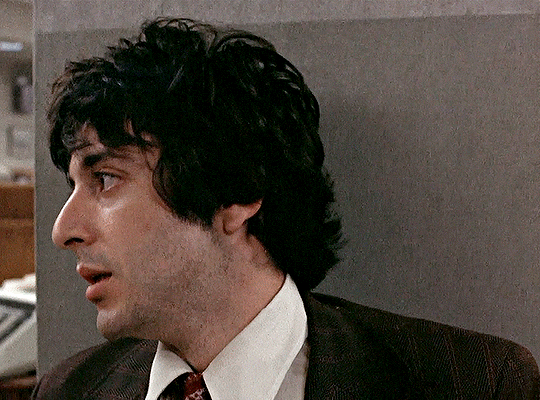
See, he rightly felt that he was undercut for selling his story for the screenplay. Which, given how successful the movie was, is totally fair. He was also upset at the portrayal of his ex-wife in the movie, which portrayed her as an annoying overweight woman whom he kinda hated. And she wasn’t that at all, and John was an honorable guy, it turns out. Still, despite John’s grievances, the movie is an American classic, as well as one of the first movies to prominently feature an LGBT person as the main character. It’s important in multiple ways, is what I’m saying.

John Wotjowicz died in 2006 at the age of 60, while Elizabeth sadly died of AIDS-related pneumonia in 1987, after getting the virus from a blood transfusion. Which, damn, that’s horrible. It’s honestly a fascinating story, and I get why it was made into Dog Day Afternoon. That said, though, there is an elephant in the room that needs to be addressed here. And that elephant’s name is:

See, this scene is loosely based on famous photos taken of the robbery. This actually was a huge deal at the time, and scenes of John outside wearing this exact shirt-pants combo were famous. Crowds gathered to watch, just like in the movie, and it was a huge deal. But, uh...the Attica thing? Never happened. See, in the movie, Sonny riles up the crowd by shouting “ATTICA! ATTICA! ATTICA!” Getting the crowd to join in. This was a reference to the Attica Prison Riots, which took place a year before. 43 men died in the riots, making it the deadly riot in US prison history, and it was a step in the prisoner’s rights movement of the day. So, invoking this is kind of a big deal. And Pacino improvised the whole thing.
Yeah, this didn’t actually happen! Pacino made this up himself, stoking the crowd’s memory of injustice enough to rile them up and make this scene memorable. And yeah, the crowd was improvising, too! They weren’t even extras, they were just people who wandered in off the street to watch the movie shoot! And they were also really good at being a crowd. They cheered on cue, they booed on cue, they moved on cue, they were...frankly, they were incredible. But yeah, this is technically not true.

That said, there was a crowd there at the time, and they really did cheer and jeer throughout the day. An addition that the movie makes, though, is the addition of LGBT crowd members that protested for gay rights. And while I can’t find a lot of proof of this happening (there is some proof, just not much), it wouldn’t be a big surprise, given what I talked about earlier. Three years after Stonewall, the topic was still on everybody’s consciousness, so having crowd members there does make sense.
Sidney actually called members of the Gay Liberation Movement and Gay Activist Alliance, organizations that were born directly as a result of Stonewall, so that they would be members of the crowd. And one of those members that showed up?
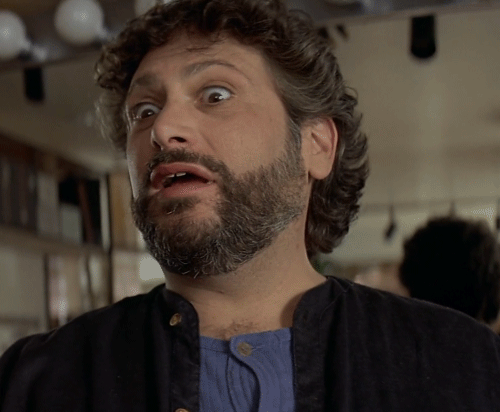
Yeah. A teenaged Harvey fuckin’ Fierstein. Awesome.
So, yeah, this movie was a big deal for LGBT rights and representation, because the event itself is an interesting footnote in LGBT history. So with all of that said...how was the movie itself? Well...
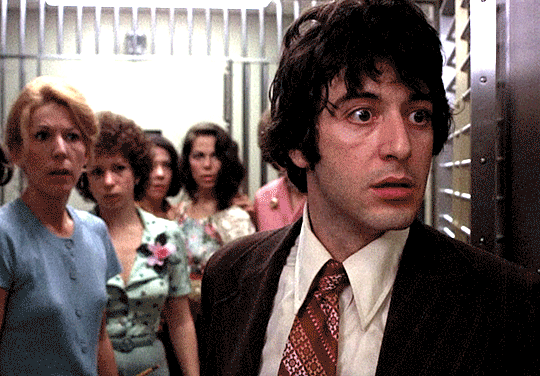
Review: 90%
Um, it’s a really fucking good movie. Is that a surprise, though? I know I normally talk through the movie more, but I don’t think I really needed to this time around. The original story and its background is fascinating. But yeah, the movie absolutely rules, don’t get me wrong. Let’s break it down a bit!
Cast and Acting - 9/10: Unsurprisingly, Al Pacino is stellar. But in truth, everybody’s pulling their weight here. Outside of a few bit parts that don’t work perfectly (mostly in the hostages, sorry Carol Kane), this story is wonderfully portrayed. Also, fun fact, one of the main hostages was played by Penelope Allen, who was actually sort of Pacino’s surrogate mom early in his career. And then they got to act together, which is super sweet! I loved the acting in this one.
Plot and Writing - 9/10: Even though it’s not perfectly accurate in a lot of ways, the movie is damned engrossing in terms of story. Written by Frank Pierson, it’s a story about a sad sack bank robber and his paranoid friend who commit a pretty brave robbery for the time period. It’s a movie where the audience and the characters actually sympathize with the robbers, and it successfully puts them in a sympathetic light. And this is a man in love with a trans woman in 1972. How on Earth did Lumet get this to work as well as he did? Seriously, this is a great story, and very well-written besides.
Direction and Cinematography - 9/10: And yet one more for the 9/10 column with direction by Sidney Lumet and cinematography by Victor J. Kemper. This movie feels like you’re there, like it’s happening right in front of you. And you’re thrust into this impossibly stupid plan, that you can’t help but hope succeeds somewhere deep down in your soul. The immersion that this movie possesses is genuinely impressive, and Lumet is very good at his job. There’s a reason the Attica scene is one of the most famous in cinema.
Production and Art Design - 10/10:Look...I really like this movie. And that immersion I mentioned in the last category is only partially direction. The rest of it? Pure and unadulterated design. Pacino IS Wotjowicz, and that’s down to appearance as much as it is acting. This movie looks great and puts you square in 1972 New York. Which, sure, it was only filmed 3 years later in NYC, so that makes sense, but still; it really felt like I was there.
Music and Editing - 8/10: And finally...wait, this movie had music? It...doesn’t. Oh. OH! That’s why I don't remember any music here. And that was...noticeable, in both a good and a bad way. In a bad way because some scenes got a little draining without it. But in a good way because...to be honest, music was entirely unnecessary. The diegetic sound was the only source of sound in the movie, and it...worked. It really made the whole thing more real and immersive. But that said...sound editing was a little dodgy sometimes. Sure, it’s the ‘70s, with ‘70s film sound quality, but it was still noticeable when Sonny went from inside to outside, just saying. It’s really the only criticism I’ve got, so I’m sticking with it.
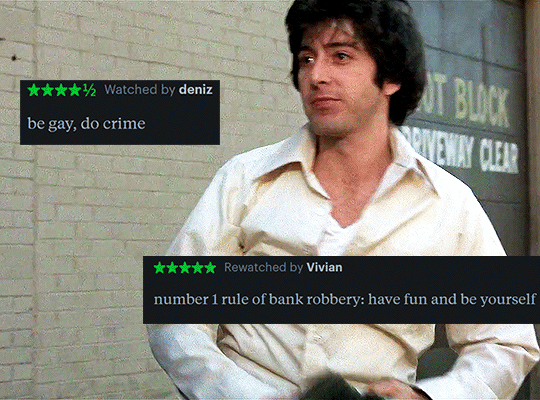
So, there you have it: a fantastic movie, and an opportunity to talk about NYC and LGBT history! Neat, huh? If you read this whole thing, then...wow geez, thank you for that. For the next one...let’s hang out in NYC for a while. I’m watching crime movies, and something tells me that this place is lousy with the stuff. We’ll be here for a little while.
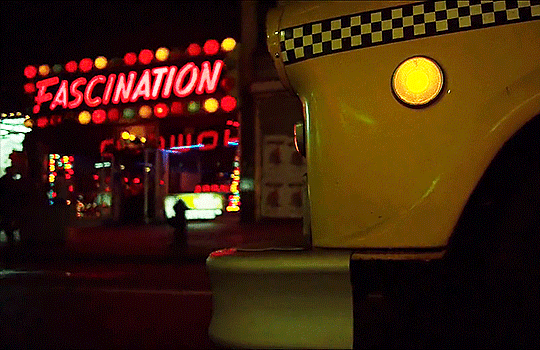
Next: Taxi Driver (1976); dir. Martin Scorcese
#dog day afternoon#f:dog day afternoon#film:dog day afternoon#roman polanski#al pacino#john cazale#james broderick#charles durning#chris sarandon#penelope allen#sully boyar#user365#365 days 365 movies#31 to life#31 films to life#crime film#crime movie#lgbt film#userkeanu#userstream#filmedit#adaptationsdaily#melisgifs
7 notes
·
View notes
Text
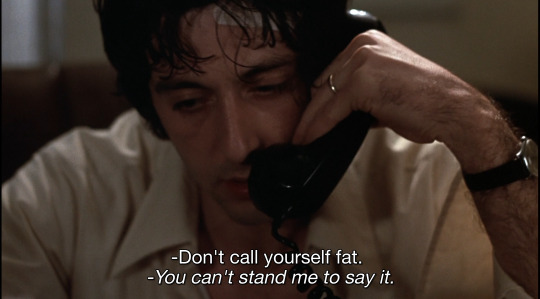

Dog Day Afternoon (1975) dir. Sidney Lumet
#Dog Day Afternoon#movie#1970s#собачий полдень#Al Pacino#John Cazale#Charles Durning#Chris Sarandon#Penelope Allen#Sully Boyar
94 notes
·
View notes
Text
Dog Day Afternoon (1975)

Fun Fact: The real-life incident became a part of police training on how to deal with hostage situations and crowds that were out of control.

Another Fun Fact: The real bank robber, John Wojtowicz, had watched The Godfather (1972) to get ideas the day he robbed the Chase Manhattan bank. Both Al Pacino and John Cazale starred in The Godfather (1972).

Stevie: Sonny, I'm getting really bad vibes. Sonny: What are you talking about? Stevie: Maybe we should take something smaller, Sonny. Sonny: Are you crazy? It started already. He's got the gun out.



Sonny: Hey, you! Manager! Fucker! Don't get ideas. I bark. That man there. [points to Sal] Sonny: See him? He bites. Sheldon: Believe me, I'm on your side! Sonny: On my side, shit! Sylvia: Listen, we've got young girls, here. You could watch your language, you know! Sonny: I speak what I feel, you know. "Watch my language". Empty the drawer out!


Sonny: He's got asthma. They make him a guard? Mulvaney: Well, they go to guard school. Sonny: Alright, to learn what? How to shoot? He don't even have a gun. Mulvaney: They earn $105 a week to fold a flag.








Sal: Wyoming. Sonny: No, Wyoming... that’s not a country.


Pizza Delivery Guy: I’m a fucking star!










For funsies, here’s the news story from the actual event this film is based on:
youtube
And also interesting, the very short wiki page for Elizabeth Eden, the real-life “Leon”.

ESE: 95/100
50 +5 for Stevie +10 for young Carol Kane +5 for the bank manager +5 for “Those are my girls! I’m going back in there!” +10 for Attica! Attica! +10 for trying to rob a bank for his trans wife’s gender reassignment surgery -5 for the cops trying to pressure Leon -5 for bank manager not leaving when Sonny says he can +10 for LGBTQ+ community +5 for the limo guy -10 for the limo guy lying -5 for shooting Sal +10 for safe hostages
#Dog Day Afternoon#Lance Henriksen#Al Pacino#Carol Kane#John Cazale#Charles Durning#Chris Sarandon#James Broderick#Dominic Chianese#Penelope Allen#Beulah Garrick#Sully Boyar#Susan Peretz#drama#suspense#thriller#crime#biography#70s films#70s movies#movies#films#review#world record
41 notes
·
View notes
